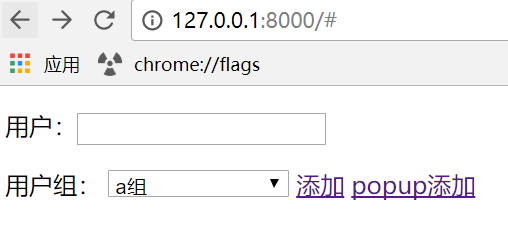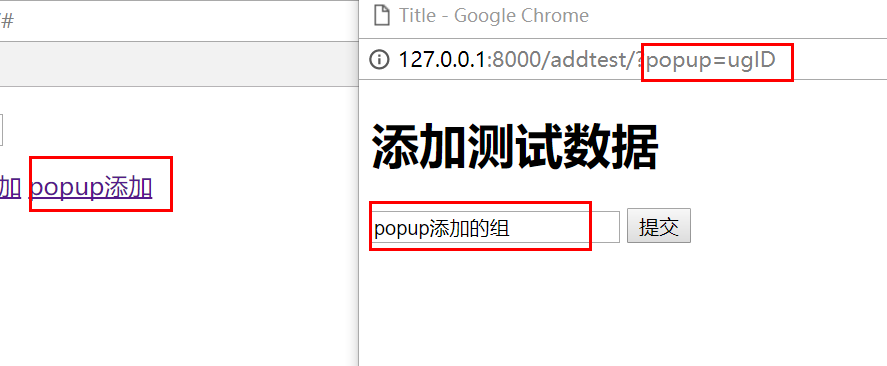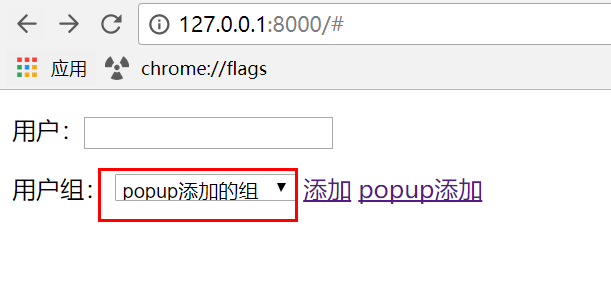popup
一、popup流程
1、add/edit页面,针对fk、m2m的那些值,绑定新增窗口的函数,且定义callback函数。
url得带一些参数,比如?popid=xxx,以方便回调时查找该id进行修改值
<script> function popupCallBack(data_dict){ var tag = document.createElement("option"); tag.innerHTML = data_dict.text; tag.setAttribute("value",data_dict.pk); tag.setAttribute("selected","selected"); document.getElementById(data_dict.popid).appendChild(tag); } function popupUrl(url){ window.open(url,"win_name","status=1,height:500,width:600,toolbar=0, resizeable=0"); } </script>
2、通过新窗口添加该值,通过views.py判断,如果是popup则返回render(popup页面),再调用callback函数
popid = request.GET.get("popup") if popid: # 通过popup新创建一个页面 title = request.POST.get("title") obj = models.UserGroup.objects.create(title=title) # response = {"id":obj.id,"title":obj.title} # 1.关闭popup页面 # 2.将新增数据添加,传送到原来发送pop页面中的ugID标签位置 popid=popID context = { "data_dict":{"pk":obj.pk,"text":obj.title,"popid":popid} } return render(request,"popup_response.html",context)
3、添加完成后,callback函数修改本页面的option值
function popupCallBack(data_dict){ var tag = document.createElement("option"); tag.innerHTML = data_dict.text; tag.setAttribute("value",data_dict.pk); tag.setAttribute("selected","selected"); document.getElementById(data_dict.popid).appendChild(tag); }
二、实例

urlpatterns = [ # path('admin/', admin.site.urls), re_path("^$",views.index,name="haha"), re_path("^addtest/$",views.add_test), ]

from django.shortcuts import render,HttpResponse from app01 import models def index(request): ''' 访问初始页,添加数据 ''' user_group_list = models.UserGroup.objects.all() context = { "user_group_list":user_group_list } return render(request,"test.html",context) def add_test(request): """ FK的添加页面,可以使popup的,也可以使正常的 """ if request.method == "GET": return render(request,"add_test.html") else: popid = request.GET.get("popup") if popid: # 通过popup新创建一个页面 title = request.POST.get("title") obj = models.UserGroup.objects.create(title=title) # response = {"id":obj.id,"title":obj.title} # 1.关闭popup页面 # 2.将新增数据添加,传送到原来发送pop页面中的ugID标签位置 popid=popID context = { "data_dict":{"pk":obj.pk,"text":obj.title,"popid":popid} } return render(request,"popup_response.html",context) else: # 正常操作 title = request.POST.get("title") models.UserGroup.objects.create(title=title) return HttpResponse("列表页面:所有")

<!DOCTYPE html> <html lang="en"> <head> <meta charset="UTF-8"> <title>Title</title> </head> <body> <p>用户:<input type="text"></p> <p>用户组: <select name="" id="ugID"> {% for user_group in user_group_list %} <option value="{{ user_group.id }}">{{ user_group.title }}</option> {% endfor %} </select> <a href="/addtest/">添加</a> <a href="#" onclick="popupUrl('/addtest/?popup=ugID')">popup添加</a> </p> <script> function popupCallBack(data_dict){ var tag = document.createElement("option"); tag.innerHTML = data_dict.text; tag.setAttribute("value",data_dict.pk); tag.setAttribute("selected","selected"); document.getElementById(data_dict.popid).appendChild(tag); } function popupUrl(url){ window.open(url,"win_name","status=1,height:500,width:600,toolbar=0, resizeable=0"); } </script> </body> </html>

<!DOCTYPE html> <html lang="en"> <head> <meta charset="UTF-8"> <title>Title</title> </head> <body> <h1>添加测试数据</h1> <form method="POST"> {% csrf_token %} <input type="text" name="title"> <input type="submit"> </form> </body> </html>

<!DOCTYPE html> <html lang="en"> <head> <meta charset="UTF-8"> <title>正在关闭的popup页面</title> </head> <body> <script> // 将数据传送给发起popup的页面 var data_dict = {{ data_dict|safe }} opener.popupCallBack(data_dict); window.close(); </script> </body> </html>
第一步,访问初始页面,添加userinfo数据,此为test.html

第二步,通过popup添加用户组,此为add_test.html

第三步,添加完成,views.py判断是popup,返回popup_response.html,调用callback函数,callback函数把用户组修改为刚添加的值





 浙公网安备 33010602011771号
浙公网安备 33010602011771号